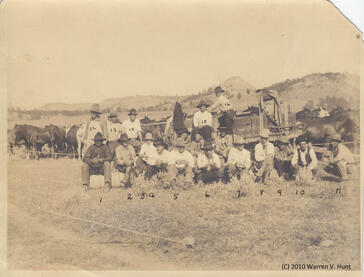Roundup Crew Photos from Montana/Wyoming - Circa 1918
Photos and text courtesy of Warren Hunt
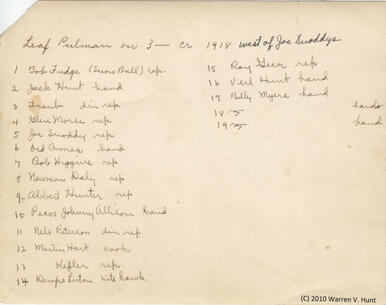
Wyoming Montana Cattle Roundup Crew
Text on back of Roundup Photo-
My father, Verl L Hunt, was a lifetime amateur photographer. He had an interesting procedure he performed on most of his photos. On the reverse side of his photos he would write a short description of what and who was depicted in the picture. He went one step further on the picture of the cattle roundup crew. He wrote a number on each person in the photo and then matched that number with the proper name and title of that individual on the reverse side of the picture.
My name is Warren V Hunt, son of Verl L. Hunt
At some point in our history, my father gave me a collection of his photographs including the one of the cattle roundup crew. My youngest son, Brian Hunt, scanned many of these photos into his computer in order to distribute them to other family members.
My father is labeled as Number 16 and as a hand on the crew. My uncle, Jack Hunt, is at Number 2 also a hand. Bob Fudge is designated by Number 1 as a Snow Bull rep. Bob gained national fame at a later date in a book by Jim Russell entitled Texas Trail Driver – Montana Wyoming Cowboy 1862 – 1933.
During the days of my youth on my father's ranch I met many of these crewmembers. At one time or another, I also saw most of their ranches and their headquarter buildings. When my father would meet them on the street of Gillette, the city of choice for most, it would lead to a long visit on the sidewalk.
My father and the old crewmembers seemed to enjoy visiting with each other whenever they met casually.
I am so impressed with the Cowboy Showcase that I am submitting the cattle roundup crew photo to them for use on their Web page.
Text on back of Roundup Photo-
My father, Verl L Hunt, was a lifetime amateur photographer. He had an interesting procedure he performed on most of his photos. On the reverse side of his photos he would write a short description of what and who was depicted in the picture. He went one step further on the picture of the cattle roundup crew. He wrote a number on each person in the photo and then matched that number with the proper name and title of that individual on the reverse side of the picture.
My name is Warren V Hunt, son of Verl L. Hunt
At some point in our history, my father gave me a collection of his photographs including the one of the cattle roundup crew. My youngest son, Brian Hunt, scanned many of these photos into his computer in order to distribute them to other family members.
My father is labeled as Number 16 and as a hand on the crew. My uncle, Jack Hunt, is at Number 2 also a hand. Bob Fudge is designated by Number 1 as a Snow Bull rep. Bob gained national fame at a later date in a book by Jim Russell entitled Texas Trail Driver – Montana Wyoming Cowboy 1862 – 1933.
During the days of my youth on my father's ranch I met many of these crewmembers. At one time or another, I also saw most of their ranches and their headquarter buildings. When my father would meet them on the street of Gillette, the city of choice for most, it would lead to a long visit on the sidewalk.
My father and the old crewmembers seemed to enjoy visiting with each other whenever they met casually.
I am so impressed with the Cowboy Showcase that I am submitting the cattle roundup crew photo to them for use on their Web page.
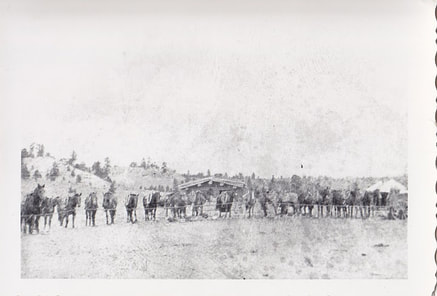
Prior to Moving the Herd
It is amazing to many modern horse people that you could park some 25 odd horses to a rope picket line tethered about waist high as shown in this photo.
This collection of horses resulted from a work break ordered by the cow boss on a hot day in July.
It is amazing to many modern horse people that you could park some 25 odd horses to a rope picket line tethered about waist high as shown in this photo.
This collection of horses resulted from a work break ordered by the cow boss on a hot day in July.

Prior to Moving the Herd - notation on reverse side of photo.
Evidently this roundup met with some success as indicated by the remark about taking 2500 steers to Moorcroft, Wyoming. This job was left to the hands of the crew as the representatives left the group at this point. The route to Moorcroft meant that the herd would be taken east to the Little Powder River and then south along the Little Powder River to Moorcroft. This would make it easy to water the herd during the several days required to make that trip of some 80 miles. Moorcroft was chosen as a destination since the Chicago Burlington and Quincy Railroad (CBandQ) ran freight trains from there to Omaha and Chicago.
Evidently this roundup met with some success as indicated by the remark about taking 2500 steers to Moorcroft, Wyoming. This job was left to the hands of the crew as the representatives left the group at this point. The route to Moorcroft meant that the herd would be taken east to the Little Powder River and then south along the Little Powder River to Moorcroft. This would make it easy to water the herd during the several days required to make that trip of some 80 miles. Moorcroft was chosen as a destination since the Chicago Burlington and Quincy Railroad (CBandQ) ran freight trains from there to Omaha and Chicago.
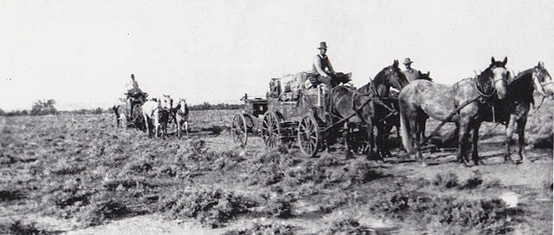
Roundup Wagons
You can readily tell which has the heavier load on board. The cook wagon in the lead has four horses in tandem pulling it.. It is loaded with boxes of food supplies and provisions for use by the cook. The bed wagon in the rear is pulled by only two horses. The two wheeled vehicle pulled behind the wagon is the actual stove unit used by the cook to heat food for the roundup crew. This entire combination of leading wagon and trailing stove is sometimes referred to as the chuckwagon.
You can readily tell which has the heavier load on board. The cook wagon in the lead has four horses in tandem pulling it.. It is loaded with boxes of food supplies and provisions for use by the cook. The bed wagon in the rear is pulled by only two horses. The two wheeled vehicle pulled behind the wagon is the actual stove unit used by the cook to heat food for the roundup crew. This entire combination of leading wagon and trailing stove is sometimes referred to as the chuckwagon.
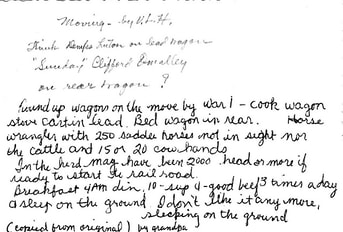
Roundup Wagons text on reverse of photo
Moving the location of a roundup crew was akin to a large military operation. As the narrator says on this page, he is talking about moving thirty people, 2,000 head of cattle, 250 saddle horses and at least two big wagons to a new campsite.
Moving the location of a roundup crew was akin to a large military operation. As the narrator says on this page, he is talking about moving thirty people, 2,000 head of cattle, 250 saddle horses and at least two big wagons to a new campsite.
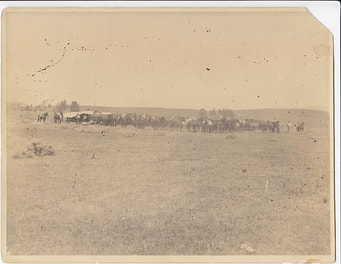
An example of approximately 250 saddle horses held in a rope corral. The corral is constructed by suspending a rope at several locations about three and a half feet above the ground.
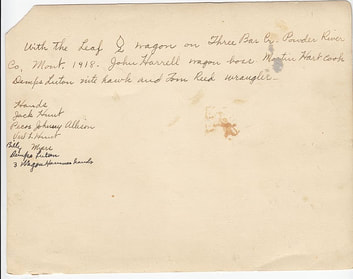
250 saddle horses held in a rope corral - text on reverse side
You can see a replica of the actual brand placed on the Leaf livestock in the first line of this page. The narrator also included a few roundup crew titles such as wagon boss, nite hawk, wrangler and hand.
You can see a replica of the actual brand placed on the Leaf livestock in the first line of this page. The narrator also included a few roundup crew titles such as wagon boss, nite hawk, wrangler and hand.
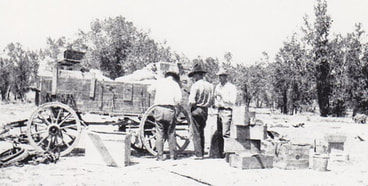
Roundup Wagon
By the looks of the boxes on the ground back of the wagon one can imagine why the Mess Wagon usually was the heaviest vehicle in the parade.
By the looks of the boxes on the ground back of the wagon one can imagine why the Mess Wagon usually was the heaviest vehicle in the parade.
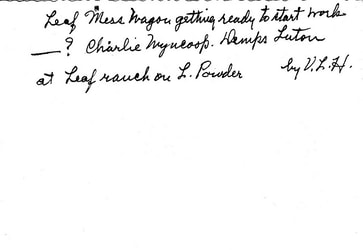
Mess Wagon text
The photo narrator has used several phrases to name the pictured vehicle. Here he calls it the Mess Wagon. In other pictures it was identified as the Cook Wagon. When attached to the trailing stove the combination became the chuckwagon.
The photo narrator has used several phrases to name the pictured vehicle. Here he calls it the Mess Wagon. In other pictures it was identified as the Cook Wagon. When attached to the trailing stove the combination became the chuckwagon.
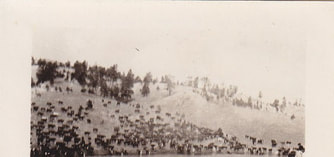
Mexican Steers
Strangely, no pictures of the 2,500 steers gathered by the roundup crew. But here is a photo of a few hundred steers walking toward a spring or pond.
Strangely, no pictures of the 2,500 steers gathered by the roundup crew. But here is a photo of a few hundred steers walking toward a spring or pond.
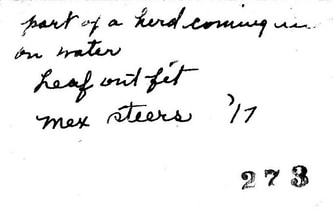
Mexican steers text
Evidently the crew found members of a special category of animals in their Montana roundup with their discovery of "Mex Steers". These were likely descendants of livestock which had survived the long trip from Texas after being originally gathered in Mexico.
Evidently the crew found members of a special category of animals in their Montana roundup with their discovery of "Mex Steers". These were likely descendants of livestock which had survived the long trip from Texas after being originally gathered in Mexico.
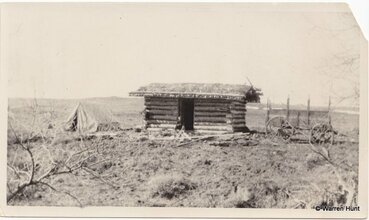
Homesteading
The Homestead Act was passed by Congress in 1862 giving applicants title to 160 acres of land after meeting residency and use regulations. In 1909, a major update called the Enlarged Homestead Act was passed allowing an increase of acreage to 320 for dry land farming. This was because much of the low lying land along rivers had been homesteaded by 1909.
Verl Hunt filed his homestead application papers in 1915 with the Enlarged Homestead Act in effect allowing him to file on land 320 acres in size. However, a large number of cattlemen had complained to lawmakers that 320 acres of dry ranch land would adequately feed only 32 head of livestock. The estimate was, and still is today, that ten acres of dry ranch land is required to feed one head of livestock. As a result, another modification of homestead law was enacted in 1916 with the Stock-Raising Homestead Act raising the acreage amount to 640 acres, or one square mile. Accordingly, Verl's homestead acreage limit was raised to 640 acres in 1916.
This photo is of Verl's homestead cabin under construction in 1915 as he was attempting to meet the residency requirements of the then-current law. It appears that he met the provision of homestead law that mandated the building of a habitable dwelling at least 12 by 14 feet in size. The cabin was constructed of pine logs harvested from Verl's initial 320 acres.
Note the canvas tent to the left of the cabin. Verl lived in this tent during the several months it took to erect the cabin into a truly habitable dwelling.
The roof construction consists of small peeled logs which were placed side by side and then covered by a slick cardboard roll to shed rainwater and snow melt. Tightly spaced squares of sod were laid down to complete the roof. This sturdy roof kept inhabitants dry for many years after its initial construction.
Even after installation of an eastward facing window, the dwelling was quite dim inside. To counter this, the log walls were painted with what was called "whitewash" which reflected the meager light from a candle or kerosene lamp.
The Homestead Act was passed by Congress in 1862 giving applicants title to 160 acres of land after meeting residency and use regulations. In 1909, a major update called the Enlarged Homestead Act was passed allowing an increase of acreage to 320 for dry land farming. This was because much of the low lying land along rivers had been homesteaded by 1909.
Verl Hunt filed his homestead application papers in 1915 with the Enlarged Homestead Act in effect allowing him to file on land 320 acres in size. However, a large number of cattlemen had complained to lawmakers that 320 acres of dry ranch land would adequately feed only 32 head of livestock. The estimate was, and still is today, that ten acres of dry ranch land is required to feed one head of livestock. As a result, another modification of homestead law was enacted in 1916 with the Stock-Raising Homestead Act raising the acreage amount to 640 acres, or one square mile. Accordingly, Verl's homestead acreage limit was raised to 640 acres in 1916.
This photo is of Verl's homestead cabin under construction in 1915 as he was attempting to meet the residency requirements of the then-current law. It appears that he met the provision of homestead law that mandated the building of a habitable dwelling at least 12 by 14 feet in size. The cabin was constructed of pine logs harvested from Verl's initial 320 acres.
Note the canvas tent to the left of the cabin. Verl lived in this tent during the several months it took to erect the cabin into a truly habitable dwelling.
The roof construction consists of small peeled logs which were placed side by side and then covered by a slick cardboard roll to shed rainwater and snow melt. Tightly spaced squares of sod were laid down to complete the roof. This sturdy roof kept inhabitants dry for many years after its initial construction.
Even after installation of an eastward facing window, the dwelling was quite dim inside. To counter this, the log walls were painted with what was called "whitewash" which reflected the meager light from a candle or kerosene lamp.
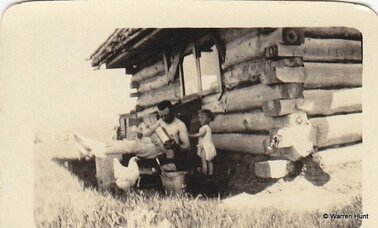
Another view of Verl Hunt's homestead cabin in 1922 as he cleans out the hand-cranked ice cream freezer. Warren Hunt at one and a half years of age is showing interest in the ice cream freezer as well. The white Leghorn hen is figuratively licking her beak as she also awaits a morsel to be dropped her way.
You are looking at the east facing wall of the cabin with a glass window installed after the earlier 1915 photo of the cabin.
Verl's homestead was located on dry ranch land twenty miles west of the Little Powder River. As a result, there was no running water on land he had chosen. Therefore, he had to make certain that natural springs seeping out at one or more locations were on the land he had selected. There were two seeping springs on the 320 acres on which he filed his initial homestead application. One of these springs was about 100 feet northeast of his cabin from which he obtained household water. As a general practice, the homestead buildings were located close to these sources of water for humans and animals.
You are looking at the east facing wall of the cabin with a glass window installed after the earlier 1915 photo of the cabin.
Verl's homestead was located on dry ranch land twenty miles west of the Little Powder River. As a result, there was no running water on land he had chosen. Therefore, he had to make certain that natural springs seeping out at one or more locations were on the land he had selected. There were two seeping springs on the 320 acres on which he filed his initial homestead application. One of these springs was about 100 feet northeast of his cabin from which he obtained household water. As a general practice, the homestead buildings were located close to these sources of water for humans and animals.
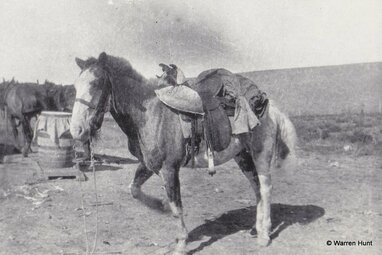
This is Frosty, Verl's favorite saddle horse. Verl rode Frosty from Powell, South Dakota to Miles City, Montana in 1914, when Verl was 23 years of age. That trip was a little jaunt of 230 miles. Verl intended to seek his fame and fortune in Montana by homesteading on one of the parcels of government land still available to applicants in 1914.
Frosty's coloring comes fairly close to making him a pinto horse. However, with his shape and temperament, he failed to become a member of the Quarter Horse Club. He did have one characteristic of coloring that set him aside from all other equines. His left eye was bright blue and his right eye was an off pink. When Frosty fixed his gaze upon you with his multicolored eyes you paid close attention.
Frosty's coloring comes fairly close to making him a pinto horse. However, with his shape and temperament, he failed to become a member of the Quarter Horse Club. He did have one characteristic of coloring that set him aside from all other equines. His left eye was bright blue and his right eye was an off pink. When Frosty fixed his gaze upon you with his multicolored eyes you paid close attention.
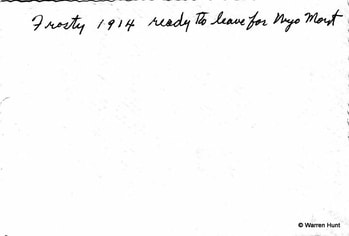
Verl’s handwriting explains why Frosty was loaded down with all that gear behind the saddle and hanging on the saddle horn.
Verl met with ultimate success as indicated by a part of a column copied from the Friday, September 24, 1926 Billings Gazette shown below. The numerical figure following each name indicates the approved acreage of each applicants land parcel.
Verl met with ultimate success as indicated by a part of a column copied from the Friday, September 24, 1926 Billings Gazette shown below. The numerical figure following each name indicates the approved acreage of each applicants land parcel.
Land Patents Arrive
For 26 Homesteaders
Patents have been received at the
Billings land office for 26 homesteaders
who have completed proof to their claims.
The patentees are as follows:
Verl L. Hunt, Bay Horse 320
Reginald T. Mellor, Coeur d'Alene 326
William B. Padness, Jordan 316
Ida M. Howe, Spokane 317
Earl K Vance, Sundance 320
August I. Eilner, Moorcroft 320
James W. Dolson, Billings 320
For 26 Homesteaders
Patents have been received at the
Billings land office for 26 homesteaders
who have completed proof to their claims.
The patentees are as follows:
Verl L. Hunt, Bay Horse 320
Reginald T. Mellor, Coeur d'Alene 326
William B. Padness, Jordan 316
Ida M. Howe, Spokane 317
Earl K Vance, Sundance 320
August I. Eilner, Moorcroft 320
James W. Dolson, Billings 320
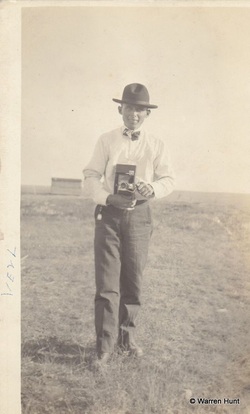
Verl Leland Hunt
Verl Leland Hunt was the individual who photographed the scenes in this Cowboys Showcase Web page. He is shown holding the camera with which he took these pictures in the photo, above. Strangely, he did not make an entry on the reverse side indicating the “who, what and date” as he did on most of his photographs.
Verl remained on his homesteaded ranch engaged in raising white-faced Hereford cattle for 41 years between 1915 and 1956. Verl married Ruth Watkins of Powell, South Dakota in 1919 and she assisted him in this endeavor.
Although Verl spent much of his working career on a saddle horse, he was quick to use the technical inventions of his days. One example of this, of course, was the camera, which he acquired during his early twenties. He added a movie camera to his list of equipment in the late 1940s.
Verl's ranch was located sixty miles from a long distance telephone or a Western Union office. As a result, it was impossible to obtain current news of the day or, more importantly, the livestock price reports from the Omaha or Chicago stockyards. In 1928, Verl purchased a Day Fan battery-operated radio with which he could obtain stock reports and news from Denver or Billings radio stations. The Day Fan reception made Verl the local guru of stock prices among the neighboring cattle ranches.
Very soon after they came out for public use, Verl acquired a magnetic tape recorder. He was somewhat of a practical joker, which led him to record people’s voices when they were not aware the machine was on and then joined in the laughter as the episode was played back.
For many years Verl and Ruth had collected pretty stones in their travels. Verl began cutting and polishing stones in 1956 to make a wide selection of jewelry for female family friends and relatives. He cut and polished rocks from 1956 until his death in 1971.
In 1951, Verl entered into the most technically complicated field of his career. He obtained his private pilot's license and purchased a Piper Aircraft Model J3. His logic for this purchase was that it gave him a quick and convenient way to check the grass conditions and inspect cattle watering holes on some 12 sections of land he had acquired or leased by 1951. However, he used the airplane to visit neighboring ranches or relatives more often than "riding the range" on his own land. He owned a couple of small airplanes after the J3 and flew until 1962 when he was 71 years of age.
We now say farewell to Verl Leland Hunt, an amateur photographer who took most of the photos used on this Web page. He lived in a unique era, which bridged his life working closely with Hereford cattle throughout the entire period. At the beginning of this story he was astride a saddle horse in one of the last open range cattle roundups. The story closes in the preceding paragraph with Verl piloting his own airplane to conduct an aerial inspection of his cattle and land. Verl was a rare individual who progressed from close contact with horses and Herefords to flying his own airplane all within his life span.
Photos and text courtesy of Warren Hunt
Editor's note:
We received this message from Warren's family:
"Warren Hunt died early Friday morning (Feb 14, 2014) quite peacefully at the age of 93. He is survived by three children, three step-children, a granddaughter, and a great nephew. We will miss the old cowboy dearly. If possible, we may make a trip this summer to return his ashes to the old Wyoming ranch."
We are honored to have published Warren's notes and his father's photos. His passing emphasizes the importance of getting these memories and other items down while the people who lived them are still with us.
Verl Leland Hunt was the individual who photographed the scenes in this Cowboys Showcase Web page. He is shown holding the camera with which he took these pictures in the photo, above. Strangely, he did not make an entry on the reverse side indicating the “who, what and date” as he did on most of his photographs.
Verl remained on his homesteaded ranch engaged in raising white-faced Hereford cattle for 41 years between 1915 and 1956. Verl married Ruth Watkins of Powell, South Dakota in 1919 and she assisted him in this endeavor.
Although Verl spent much of his working career on a saddle horse, he was quick to use the technical inventions of his days. One example of this, of course, was the camera, which he acquired during his early twenties. He added a movie camera to his list of equipment in the late 1940s.
Verl's ranch was located sixty miles from a long distance telephone or a Western Union office. As a result, it was impossible to obtain current news of the day or, more importantly, the livestock price reports from the Omaha or Chicago stockyards. In 1928, Verl purchased a Day Fan battery-operated radio with which he could obtain stock reports and news from Denver or Billings radio stations. The Day Fan reception made Verl the local guru of stock prices among the neighboring cattle ranches.
Very soon after they came out for public use, Verl acquired a magnetic tape recorder. He was somewhat of a practical joker, which led him to record people’s voices when they were not aware the machine was on and then joined in the laughter as the episode was played back.
For many years Verl and Ruth had collected pretty stones in their travels. Verl began cutting and polishing stones in 1956 to make a wide selection of jewelry for female family friends and relatives. He cut and polished rocks from 1956 until his death in 1971.
In 1951, Verl entered into the most technically complicated field of his career. He obtained his private pilot's license and purchased a Piper Aircraft Model J3. His logic for this purchase was that it gave him a quick and convenient way to check the grass conditions and inspect cattle watering holes on some 12 sections of land he had acquired or leased by 1951. However, he used the airplane to visit neighboring ranches or relatives more often than "riding the range" on his own land. He owned a couple of small airplanes after the J3 and flew until 1962 when he was 71 years of age.
We now say farewell to Verl Leland Hunt, an amateur photographer who took most of the photos used on this Web page. He lived in a unique era, which bridged his life working closely with Hereford cattle throughout the entire period. At the beginning of this story he was astride a saddle horse in one of the last open range cattle roundups. The story closes in the preceding paragraph with Verl piloting his own airplane to conduct an aerial inspection of his cattle and land. Verl was a rare individual who progressed from close contact with horses and Herefords to flying his own airplane all within his life span.
Photos and text courtesy of Warren Hunt
Editor's note:
We received this message from Warren's family:
"Warren Hunt died early Friday morning (Feb 14, 2014) quite peacefully at the age of 93. He is survived by three children, three step-children, a granddaughter, and a great nephew. We will miss the old cowboy dearly. If possible, we may make a trip this summer to return his ashes to the old Wyoming ranch."
We are honored to have published Warren's notes and his father's photos. His passing emphasizes the importance of getting these memories and other items down while the people who lived them are still with us.
